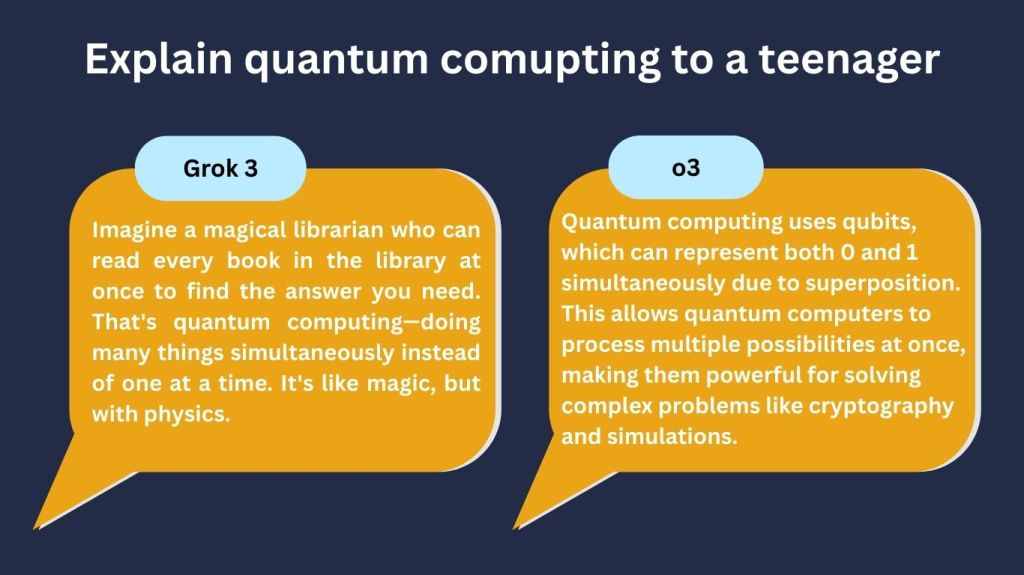As generative AI continues to evolve, we’re seeing a clear divergence in how different models are built—and for whom they’re built. Two recent entries, xAI’s Grok 3 and OpenAI’s o3 (a placeholder for their next-gen model after GPT-4), highlight that split more than ever.
Both are powerful. Both are fast-moving. But their priorities, tone, and potential use cases couldn’t be more different.
Let’s explore how these models compare and what they might mean for businesses looking to put AI to work in practical, scalable ways.
Two models, two very different directions
Grok 3 comes from Elon Musk’s xAI, and it’s built to feel fast, opinionated, and conversational—almost like a real-time sidekick. It lives inside X (formerly Twitter), responding to trending topics and interacting directly with social content. The model doesn’t aim for neutrality. In fact, it leans into a more casual, even irreverent tone.
By contrast, o3 is OpenAI’s continuation of the GPT line. Though details are still emerging, it builds on GPT-4’s architecture with upgrades in reasoning, accuracy, and multimodal capabilities (handling both text and images). It’s designed with a wide range of enterprise-grade use cases in mind—from internal tooling to customer-facing applications.
In short, Grok is positioned as a cultural AI; o3 is designed to be a business asset.

Training approach and alignment philosophy
A lot of what makes these models feel different comes down to how they’re trained and aligned.
Grok 3 is likely tuned on data drawn from X’s social content, real-time conversations, and less-filtered information sources. It’s trained to be bold and responsive—even if that sometimes means crossing into edgy topics or opinions.
OpenAI’s approach with o3 is more structured. The training data is highly curated. Model alignment focuses on factual accuracy, safety, and compliance with enterprise needs. If Grok is the AI equivalent of improvisation, o3 is a trained specialist following best practices.
That difference matters for organizations with strict standards around bias, safety, or governance.
| Feature / Focus Area | Grok 3 (xAI) | o3 (OpenAI) |
|---|---|---|
| Tone & Personality | Witty, casual, opinionated | Polished, neutral, professional |
| Primary Use Case | Real-time conversation, cultural commentary | Enterprise tools, automation, structured tasks |
| Training Philosophy | Less filtered, real-time data from X and web | Curated, filtered datasets with alignment to safety and trust |
| Multimodality | Early-stage (text-first, may expand later) | Advanced (text, image, memory, file uploads, tools) |
| Integration | Native to X platform | API-ready, ChatGPT Enterprise, embeddable in apps |
| Developer Support | Limited (currently no open developer portal) | Robust (API, plugin support, SDKs, documentation) |
| Risk & Compliance | Lower guardrails, more expressive | High alignment focus, enterprise-ready security |
| Best Fit For | Creators, social apps, casual content | Teams needing structure, performance, and dependable output |
👋 Are you looking for AI consulting in your business?
We offer personalized consulting, strategy, and technical execution based on your goals.
Trusted by tech leaders at:



How they perform across real use cases
Here’s where things get more practical.
For creative ideation or social engagement, Grok 3 can feel more spontaneous. It’s responsive in tone and can adapt to the energy of a fast-moving digital conversation. For example, Grok might be a fit if you’re looking to generate informal content or integrate an AI that “feels” human in a live stream.
However, when it comes to structured tasks—code generation, technical research, summarization, and complex workflows—o3 delivers a more consistent and reliable experience. It integrates more easily with APIs and toolchains. It respects formatting and handles long, multi-step requests with less risk of hallucination or tone drift.
o3 also brings access to OpenAI’s expanding ecosystem of tools: file uploads, browsing, advanced memory, and real-time collaboration features that are valuable across departments.
Enterprise-readiness and integration options
Here is where the gap widens.
Grok 3 is integrated directly into the X platform. It’s fast and reactive but not built (at least yet) with enterprise deployment in mind. There’s no formal developer API or business portal, and limited visibility into roadmap or SLAs.
o3, on the other hand, is already available through OpenAI’s API, embedded in ChatGPT Enterprise, and supported across third-party tools. You can build workflows around it, run tests at scale, and access detailed documentation and support.
For companies building production-grade AI experiences, this level of infrastructure and stability is a critical factor.
Bottom line: Different tools for different needs
This isn’t about one model being “better” than the other—it’s about alignment. Grok might be worth exploring if your team needs a lightweight, fast-response AI that mimics real-time human interaction. However, for deeper integrations, complex use cases, and long-term value, o3 offers more maturity and control.
And as always, AI is evolving quickly. What matters most is not picking a single tool—but having a clear strategy for evaluating, testing, and deploying the right tools for your use case.
Thinking about integrating AI into your business systems?
Curotec helps companies move beyond experimentation. From selecting the right model to deploying it within real-world applications, we’ll guide your team securely, responsibly, and with real business outcomes in mind.
Contact us so we can explore what’s possible together!



